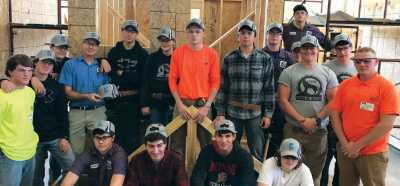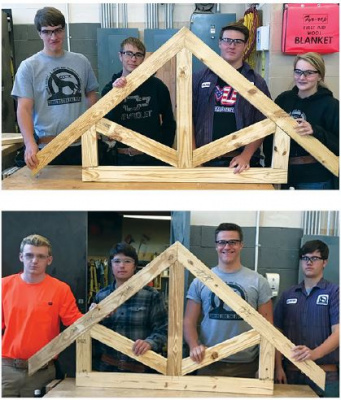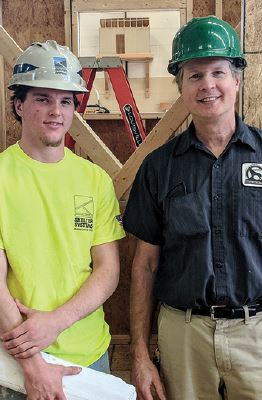Show Them You Care (Bring Pizza if Necessary)
Show Them You Care (Bring Pizza if Necessary)
“People don’t remember what you say, they remember how you make them feel,” asserts Margaret Welliver, human resources manager at Shelter Systems Limited in Westminster, Maryland. And when she says “people” she’s talking about students, in particular those she and colleague Randy Rickels have come to know at Carroll County Career & Technology Center (CCCTC).

According to Jon Mersinger, head of CCCTC’s construction program, the relationship started four or five years ago when the school went to Shelter requesting support for their Skills USA carpentry team’s trip to nationals, a competitive event showcasing the best career and technical education from across the nation. Shelter supported them, and things grew in a way that has set the company apart in Jon’s opinion. “Many companies want the students but don’t want to give back,” he explains. “Shelter is different. They showed not only an interest in recruiting the students, but an interest in the kids. It wasn’t a one-sided thing.”
One way Shelter has taken an interest in Jon’s students is by becoming active in his classroom. In 2016, Randy visited an entry-level class to introduce careers in the industry aside from field construction, while covering some basics like, “What does it take to be a good employee? What are we looking for?” But the real winner was what Randy brought with him for the students to do – build trusses.

“Randy gave them lumber and a truss design, broke them up into teams and told them how to get to the final truss in the most appropriate and quality way,” Margaret explained. “Each group approached it differently and at the end there were multiple ways to reach to the same result.”
“From the very beginning, I said we weren’t going to go in there with some boring Power-Point presentation,” declares Randy, Shelter’s lead production trainer. “These kids are used to physical labor. They want to be hands-on. So I had one of our designers create a valley truss and I provided the lumber they needed.” For Randy, the best part was watching the students use the design to figure out how to cut the correct angles. “There was nothing automated. They were figuring it out from the design sheet,” he explains. “They asked questions and figured out how to work together.”
This experience resulted in two paid interns for Shelter in the spring of 2017 and a much higher bar for anyone wanting to get in front of Mr. Mersinger’s students: “No one can ever do a PowerPoint for these students again!”
Randy and Margaret returned to Jon’s classroom in fall 2017 to repeat the team truss-building exercise. “It’s interesting from an HR perspective to watch [the students] work together,” says Margaret. “I can see the leaders come out. Some immediately took charge in their groups – asking questions about who does what, negotiating how to work as a team – tremendous skills sometimes missed in regular education that are taught in career tech education.”
The classroom activity was followed up with a plant tour this past January, an unusual outing for a school that doesn’t typically do field trips. “That was a great opportunity to get our name out in the community and meet with kids who could be wonderful employees,” says Margaret. The students had an opportunity to use PPE, spent some in-depth time on the production floor, and enjoyed some pizza.
Jon explained that his objectives for the field trip to Shelter’s plant were fairly extensive. He wanted to provide exposure to the manufacturing process, industrial safety protocols, the work environment, worker productivity compensation, and the tools of manufacturing, while demonstrating how the skills and knowledge the students were gaining in his carpentry program could be applied in a work setting. “In our pre-visit discussion, I presented my objectives to the class,” he remembers. “They appeared to be, as expected, more interested in prognosticating the selection of pizza toppings than in my expectations of what they should learn from the experience.” But this is precisely why Jon says he values CCCTC Carpentry’s relationship with Shelter. In a follow-up letter to Shelter’s general manager Lenny Mills after the tour, Jon expressed his heartfelt appreciation for everything Shelter has provided his students:
You were able to provide an experience that, from an adolescent’s educational perspective, may seem mundane and boring and made it inspiring, interesting, and fun. It is plainly evident through your interactions with these young, career-aspiring individuals that your organization has a genuine interest in their transition from student to employee. That is what separates your organization from the others that I am associated with.
I would also like to acknowledge the work of Randy and Margaret. Through your gracious generosity, they are permitted the time to visit our classroom and administer a learning exercise that has evolved into an eagerly anticipated event. I have observed intently their interactions with the students. Their warmth of character and compassionate demeanor radiates an aura of approachability that disarms student inhibitions to ask questions and perpetuates an atmosphere of maximum performance.
My students know, through the experiences you have provided, that Shelter Systems Limited is a well-run organization that genuinely cares about their business and the individuals they employ.
Jon says that many employers want face time with his students but he is hesitant to let companies in unless they are willing to present something useable for the students. He explains that Shelter doesn’t just talk about what they need to know to gain employment, but how to advance in their employment. “[At CCCTC] we make sure that the students know there is a path you can follow to prosperity and a decent life,” says Jon. “For an employer to come out and give them a path to prosperity, that gets their attention and gets them thinking.”

Brandon started out building roof trusses for Shelter in July of last year, and now splits his time between truss building and operating the automated component saw. He says the Tech Center prepared him to be able to stay on top of everything.
Shelter got Brandon Holmes’ attention. A 2017 graduate of Mr. Mersinger’s program, Brandon didn’t do an internship but knew about Shelter because of their relationship with the school. According to Randy, Mr. Mersinger provides a foundation in the terminology and knowledge needed for their environment, which “makes it easier to train someone who already has an understanding for why things are what they are.”
In Brandon’s opinion, what makes the industry interesting is all the different types of trusses available. “It’s cool,” he says, “to be part of the building process and see the finished product.”
So what can CMs do more of to get students interested in the trades in general and components in particular? According to Brandon, the key is more onsite visits to get everyone to know what’s going on in component manufacturing. “Make sure they know you’re there,” he says.
As Brandon looks to the future, he sees himself continuing to progress and work his way up within the industry. “I see a pathway for that,” he says. That path included joining Randy on a recent trip to Mr. Mersinger’s class to help with the truss-building demo.
“I’ve found that there are some people who only work to live, but I’ve found that the people who really care make a difference,” explains Randy, “There are kids out there that want to work and sweat. They will strive to be here for a future and a career.” Randy says Brandon focuses on his work and takes pride in what he does: “You can tell he cares about his job and the trusses he puts out.”
“It’s clear [Randy and Margaret] care about the kids and that strikes a chord with me,” Jon declares. “And that’s who I’ll let into my program and who I’ll send my best kids.”
“[Our relationship with CCCTC] gives people in the carpentry program an opportunity to see what’s going on locally so they don’t have to travel as much,” explains Randy. Many of the students at this school are in a district that is close to Shelter, so being able to do an internship gives them an opportunity to get involved with wood trusses.” In the end, Randy is realistic: “Maybe it’s something they like, maybe it’s something they don’t like…no hard feelings. They’re young and it’s good for them to experience the hard work.”
Margaret agrees and focuses on the longer game. “It’s awesome to see these kids looking at real life scenarios,” she says. “It gives them a hands-on look at what the options are after graduation. Their job is to graduate high school, but if your plan is to enter the workforce, I tell them they need to see me.” For Margaret, it’s all about persistence. “I might meet somebody in January or February through the school system and a year later they may come back to me,” she says. “It’s about making that positive impression that this is a friendly, positive place to work.”
Interested in developing your own relationship with a local school?
Jon Mersinger provides important advice: “The first misstep is not doing the homework and putting in the time for the students. Teachers are really interested in what you’re willing to give to the students. We’re looking for companies who participate, help the students, and train them so they are ready to go out [into the workforce].”

